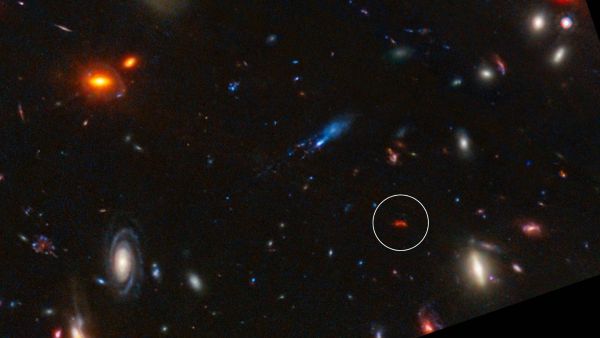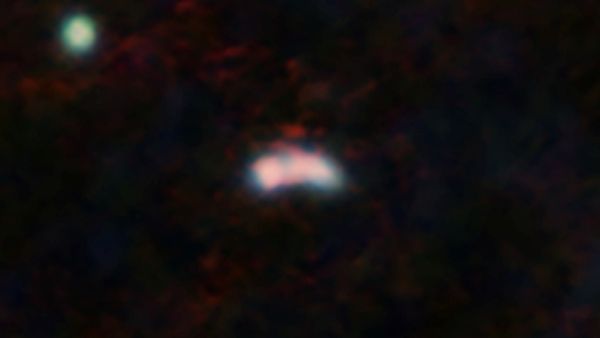Glowing deep red from the distant past: galaxy Y1 shines thanks to dust grains heated by newly formed stars (circled in this image from the James Webb telescope). Credit: NASA, ESA, CSA, STScI, J. Diego (Instituto de Física de Cantabria, Spain), J. D’Silva (U. Western Australia), A. Koekemoer (STScI), J. Summers & R. Windhorst (ASU), and H. Yan (U. Missouri)
The first generations of stars formed under conditions very different from anywhere we can see in the nearby universe today. Astronomers are studying these differences using powerful telescopes that can detect galaxies so far away their light has taken billions of years to reach us.
Now, an international team of astronomers has measured the temperature of one of the most distant known star factories. The galaxy, known as Y1, is so far away that its light has taken over 13 billion years to reach us. The study was published on Nov. 12 in the Monthly Notices of the Royal Astronomical Society.
“We’re looking back to a time when the universe was making stars much faster than today. Previous observations revealed the presence of dust in this galaxy, making it the furthest away we've ever directly detected light from glowing dust. That made us suspect that this galaxy might be running a different, superheated kind of star factory. To be sure, we set out to measure its temperature,” says Tom Bakx, lead author at Chalmers University of Technology.
Stars like our Sun are forged in huge, dense clouds of gas in space. The Orion Nebula and the Carina Nebula are two examples of such star factories. They shine brightly in the night sky, powered by their youngest and most massive stars, which light up clouds of gas and dust in many different colours.
At wavelengths longer than the human eye can see, star factories shine brightly thanks to huge numbers of tiny grains of cosmic dust, heated by starlight.
To be able to probe the galaxy's temperature, the scientists needed the superior sensitivity of ALMA. One of the world's largest telescopes, ALMA’s dry, high-altitude location made it possible to image the galaxy in just the right colour, at a wavelength of 0.44 millimetres using its Band 9 instrument.
“At wavelengths like this, the galaxy is lit up by billowing clouds of glowing dust grains. When we saw how bright this galaxy shines compared to other wavelengths, we immediately knew we were looking at something truly special,” says Bakx.
The detection showed the galaxy’s dust glowing at a temperature of 90 Kelvin – around -180 degrees Celsius. This may sound cold compared to temperatures on Earth, but it’s actually quite high for cosmic dust heated by newly born stars.
Hanae Inami, a team member and astronomer at Hiroshima University who has previously discovered a significant number of early galaxies with embedded bursty star formation through another ALMA observing program, noted her excitement about Y1’s unusually warm dust.
“Discoveries of dusty galaxies in the early universe were already exciting but finding one with such warm dust so soon after the Big Bang is even more remarkable. Y1 raises new questions — how common are galaxies with warm dust, and how do they reach such high temperatures? That’s the fun part of science: every answer brings new mysteries,” says Inami.
Galaxy Y1 and its surroundings as seen by James Webb Space Telescope’s NIRCAM (blue and green) and by ALMA (red). Credit: NASA, ESA, CSA (JWST), T. Bakx/ALMA (ESO/NRAO/NAOJ)
Y1 is manufacturing stars at the extreme rate of over 180 solar masses per year, an unsustainable pace that cannot last long on cosmological scales. On average, our galaxy, the Milky Way, creates only about one solar mass per year. Brief, hidden bursts of star formation, as seen in Y1, may have been common in the early universe, the scientists suspect.
"We don't know how common such phases might be in the early universe, so in the future we want to look for more examples of star factories like this. We also plan to use the high-resolution capabilities of ALMA to take a closer look at how this galaxy works,” says Bakx.
The researchers believe that galaxy Y1 may help solve another cosmic mystery. Earlier studies have shown that galaxies in the early universe appear to have far more dust than their stars could have produced in the short time they have been shining.
Astronomers have been puzzled by this, but Y1’s unusual temperature points to a solution. Team member Laura Sommovigo, astrophysicist at the Flatiron Institute and Columbia University takes up the story.
“Galaxies in the early universe seem be too young for the amount of dust they contain. That’s strange, because they don’t have enough old stars, around which most dust grains are created. But a small amount of warm dust can be just as bright as large amounts of cool dust, and that’s exactly what we’re seeing in Y1. Even though these galaxies are still young and don’t yet contain much heavy elements or dust, what they do have is both hot and bright,” she concludes.
This article is adapted from a press release originally published by Chalmers University of Technology.

 Home
Home
















